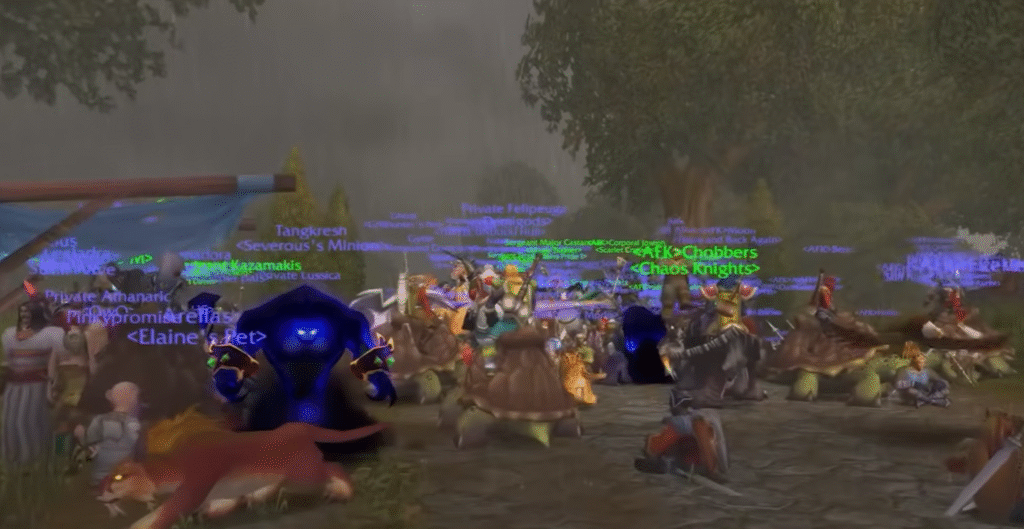The legal ramifications of Blizzard’s lawsuit against Turtle WoW, as well as the sentimental bond players have developed with the server since 2018, have generated an especially heated debate within the gaming community. By bringing this complaint, Blizzard hopes to regain control over a franchise that still has millions of fans worldwide and drastically cut down on what it considers to be illegal use of its property.
The Turtle WoW team has taken a noticeably defiant stand in recent days, assuring its community that the project will go on. The catchphrase, “Turtle WoW is here to stay,” was incredibly successful in uniting players who continue to be frustrated with Blizzard’s increasingly corporate direction. The developers reaffirmed the notion that projects driven by passion are frequently more resilient than external observers anticipate by opting for optimism over fear.
Similar issues have plagued Blizzard over the last ten years, most notably the 2016 shutdown of Nostalrius. Widespread indignation over that incident finally forced Blizzard to introduce its own official Classic servers. However, many players contend that official Classic lacked the innovation and significantly better features that Turtle WoW brought, including expansion-level content, new races, and original storylines. These additions were especially creative for fans and felt like a sincere ode to the game’s heyday.
Case Overview – Turtle WoW vs. Blizzard
| Field | Details |
|---|---|
| Case Name | Blizzard Entertainment, Inc. v. Turtle WoW |
| Date Filed | August 29, 2025 |
| Court | U.S. District Court, Central District of California |
| Defendant | Turtle WoW Development Team |
| Plaintiff | Blizzard Entertainment, owned by Microsoft |
| Allegations | Copyright infringement, unauthorized use of Blizzard’s code, art, and trademarks |
| Server Launch | 2018 |
| Player Base | Estimated 500,000 active players, peaks of 44,000 concurrent |
| Features | Custom content, new zones, races, quests, fan-made “Mysteries of Azeroth” expansion |
| Monetization | Free-to-play with donation-based in-game shop |
| Blizzard’s Claim | “Built an entire business on egregious, ongoing infringement” |
| Turtle WoW Response | “Turtle WoW is here to stay. Challenges come often, and each time we are prepared to face them.” |
| Previous Precedent | Nostalrius shutdown (2016), similar legal action against private WoW servers |
| Authentic Source | https://www.pcgamer.com |

Turtle WoW became immensely adaptable by utilizing community-driven development, striking a balance between nostalgia and new concepts. Additionally, it showed a very effective way to maintain participation by using optional donations as opposed to required subscriptions. Many found the server to be surprisingly inexpensive, even though it provided a richer experience than Blizzard’s official alternative.
The case presents very obvious issues regarding ownership versus expression in the context of intellectual property. Supporters of Turtle WoW contend that the server has produced something novel and culturally significant, while Blizzard maintains that any unauthorized use of its code and artwork is illegal. This tension is remarkably similar to disagreements in fashion, where reinterpreting classic designs leads to continuous discussions, or in music, where sampling frequently blurs the boundaries between homage and theft.
When official content pipelines slowed during the pandemic, players who were desperate for new content turned to private servers like Turtle WoW. Through online collaboration, developers added functionality that greatly enhanced pre-existing frameworks. During a period when official releases felt stale, these community initiatives kept fans interested. Turtle WoW grew internationally by forming strategic alliances with fan communities and hosting companies, breaking into markets and demographics that Blizzard had notably ignored.
The general trend is obvious: gaps in corporate vision are frequently revealed by fan-driven creativity. Servers like Turtle WoW demonstrate how incredibly powerful community passion can be in influencing cultural phenomena, much like independent films bring attention to underappreciated tales and grassroots music movements change genres. Once they get corporate attention, medium-sized creative teams often face more of a survival challenge than an innovation one.
This case might establish a significant precedent in the years to come. Blizzard may have more leverage to shut down private servers all over the world if its legal claim is successful. However, Turtle WoW may demonstrate that incredibly resilient fan projects can withstand even the most intense legal pressure if it is able to negotiate or survive. That tenacity would inspire others to push limits, guaranteeing the survival of the private development and modding culture.
The cultural symbolism of this case is what makes it so intriguing. Turtle WoW is viewed by fans as a creative haven where their opinions are valued. In contrast, Blizzard sees it as a possible security risk and an illegal resource drain. Both viewpoints are valid, but it is important to recognize the player base’s emotional complexity. After all, the community is what sustains games for decades after they are first released.
The developers of Turtle WoW have promised much faster performance and graphics that could compete with those of contemporary MMOs by incorporating Unreal Engine 5 into their future roadmap. Although this goal is very creative, it also makes Blizzard more concerned because if fan projects can provide better experiences for free, why would players still want to pay for subscriptions? That is an existential question for corporations.

